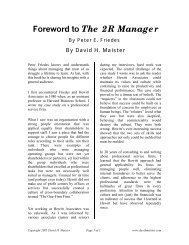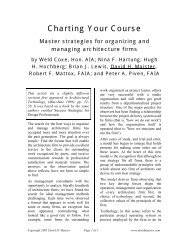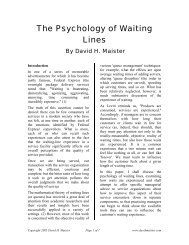pdf version - David Maister
pdf version - David Maister
pdf version - David Maister
Create successful ePaper yourself
Turn your PDF publications into a flip-book with our unique Google optimized e-Paper software.
The Anatomy of a Consulting Firm<br />
could have a significant impact on the<br />
quality of services that the firm provides.<br />
We have seen that the leverage structure<br />
and the promotion policies together<br />
determine a target (required) growth<br />
rate. It should be acknowledged,<br />
however, that there is another way of<br />
looking at the relationship between these<br />
variables. An equivalent way of stating<br />
the relationship would be to observe<br />
that, if given a growth rate and a<br />
leverage structure, the promotion<br />
incentives that result can be specified.<br />
We may see this by examining Figure 8<br />
once more. Suppose that we had<br />
constructed this by specifying the<br />
growth rate and the project team<br />
structure. We would then have<br />
discovered that we could afford to<br />
promote only four out of five juniors and<br />
one out of two managers. We would also<br />
have discovered that we would have a<br />
built-in, or target, turnover rate<br />
averaging over 4 percent (two<br />
resignations per year for the first four<br />
years, while the average number of<br />
nonsenior staff was 45.5).<br />
In this example, Guru Associates can<br />
achieve what would be considered an<br />
extremely low target turnover rate if it<br />
achieves its optimal growth. However,<br />
the norm in many consulting firms is a<br />
much higher rate than this, often<br />
reaching as high as 20 to 25 percent or<br />
even 30 percent. The key point to note<br />
here is that, given a growth rate and an<br />
organizational structure, the target<br />
turnover rate of the firm can be<br />
specified. (This does not, of course, tell<br />
us what the actual turnover experience of<br />
the firm will be. We are considering here<br />
the turnover that the firm requires to<br />
keep itself in balance. While it may be<br />
able, through its promotion system, to<br />
ensure that the actual rate does not get<br />
too low, it may have to use other devices<br />
to ensure that the actual turnover rate<br />
does not get too high through too many<br />
people quitting.)<br />
In most professions, one or more firms<br />
can be identified that have clearly<br />
chosen a high target rate of turnover.<br />
Under this scenario partners (or<br />
shareholders) can routinely earn a<br />
surplus value from the juniors without<br />
having to “repay” them in the form of<br />
promotion. This high turnover rate also<br />
allows a significant degree of screening<br />
so that only the best stay in the<br />
organization. Not surprisingly, firms<br />
following this strategy tend to be among<br />
the most prestigious in their industry.<br />
This last comment gives us the clue as to<br />
why such firms are able to maintain this<br />
strategy over time. Individuals continue<br />
to join these organizations, knowing that<br />
the odds of “making it” are very low. In<br />
the eyes of many potential recruits, the<br />
experience, training and association with<br />
the prestigious firms in the industry<br />
make the poor promotion opportunities<br />
at such firms worthwhile.<br />
Young professionals view a short period<br />
of time at such firms as a form of “postpost-graduate”<br />
degree, and often leave<br />
for prime positions they could not have<br />
achieved (as quickly) by another route.<br />
Indeed, most of the prestige firms<br />
following this strategy not only<br />
encourage this but provide active<br />
“outplacement” assistance. Apart from<br />
the beneficial effects that such activities<br />
provide in recruiting the next generation<br />
of juniors, such alumni/ae are often the<br />
source of future business for the firm<br />
when they recommend to their corporate<br />
employers hiring their old firm (which<br />
they know and understand) over other<br />
competitors.<br />
The ability to place ex-staff in<br />
prestigious positions is thus one of the<br />
Copyright 2005 <strong>David</strong> H. <strong>Maister</strong> Page 11 of 11 www.davidmaister.com











